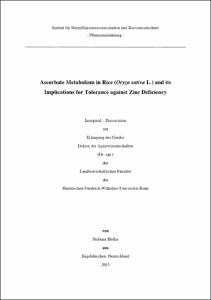Höller, Stefanie: Ascorbate Metabolism in Rice (Oryza sativa L.) and its Implications for Tolerance against Zinc Deficiency. - Bonn, 2015. - Dissertation, Rheinische Friedrich-Wilhelms-Universität Bonn.
Online-Ausgabe in bonndoc: https://nbn-resolving.org/urn:nbn:de:hbz:5n-40793
Online-Ausgabe in bonndoc: https://nbn-resolving.org/urn:nbn:de:hbz:5n-40793
@phdthesis{handle:20.500.11811/6256,
urn: https://nbn-resolving.org/urn:nbn:de:hbz:5n-40793,
author = {{Stefanie Höller}},
title = {Ascorbate Metabolism in Rice (Oryza sativa L.) and its Implications for Tolerance against Zinc Deficiency},
school = {Rheinische Friedrich-Wilhelms-Universität Bonn},
year = 2015,
month = aug,
note = {Rice is one of the most important staple crops worldwide and a growing world population will lead to an increasing demand for food in the upcoming years. Severe yield losses are threatening food security, caused by abiotic stresses such as zinc deficiency, a widespread micronutrient disorder affecting many soils worldwide. Zn deficiency can cause symptoms of oxidative stress in plants and increased ascorbate levels were suggested to enhance tolerance to zinc deficiency in rice. Ascorbate is an efficient antioxidant in plants and part of the defense system against oxidative stress. In this context, the ascorbate metabolism was investigated on a transcriptional and metabolomic level in two rice genotypes contrasting in field tolerance to zinc deficiency, RIL46 (tolerant) and IR74 (intolerant). The ability to maintain a higher ascorbate level caused by higher substrate availability and increased expression of some genes of the biosynthesis pathway was related to tolerance to zinc deficiency in RIL46. In contrast, recycling or catabolism of oxidized ascorbate was not a limiting factor under zinc deficiency in both genotypes. The process of oxidative stress formation was further investigated in different rice genotypes. One pair consisted of the above mentioned genotypes RIL46 and IR74 and another pair was represented by a TOS17 mutant line with a 20-30 % lower ascorbate level and its wild-type Nipponbare. Ascorbate protected plants efficiently from redox imbalances caused by zinc deficiency in shoots and roots. Moreover, visualization of hydrogen peroxide with different staining methods revealed that oxidative stress occurs even before the emergence of visible leaf symptoms. Additionally, T-DNA mutant lines with different ascorbate levels due to a knock-out of genes involved in the predominant D-mannose/L-galactose biosynthetic pathway were analyzed. A moderate decrease of ascorbate levels already caused increased sensitivity against abiotic stresses such as zinc deficiency and ozone stress, but not against iron toxicity. Plants with very low ascorbate levels showed severe growth defects and stress symptoms even under optimal conditions. Different ascorbate levels affected photosynthetic parameters, growth, developmental processes and yield parameters. Moreover, a knock-out in a gene taking part in a putative alternative biosynthetic pathway proceeding via myo-inositol had no impact on the ascorbate level. Thus it was suggested that the D-mannose/L-galactose biosynthetic pathway is the predominant one and that the alternative myo-inositol pathway presumably does not contribute to ascorbate biosynthesis in rice. In conclusion, ascorbate served as an efficient tolerance factor against abiotic stresses and enhanced plant fitness even under non-stressed conditions.},
url = {https://hdl.handle.net/20.500.11811/6256}
}
urn: https://nbn-resolving.org/urn:nbn:de:hbz:5n-40793,
author = {{Stefanie Höller}},
title = {Ascorbate Metabolism in Rice (Oryza sativa L.) and its Implications for Tolerance against Zinc Deficiency},
school = {Rheinische Friedrich-Wilhelms-Universität Bonn},
year = 2015,
month = aug,
note = {Rice is one of the most important staple crops worldwide and a growing world population will lead to an increasing demand for food in the upcoming years. Severe yield losses are threatening food security, caused by abiotic stresses such as zinc deficiency, a widespread micronutrient disorder affecting many soils worldwide. Zn deficiency can cause symptoms of oxidative stress in plants and increased ascorbate levels were suggested to enhance tolerance to zinc deficiency in rice. Ascorbate is an efficient antioxidant in plants and part of the defense system against oxidative stress. In this context, the ascorbate metabolism was investigated on a transcriptional and metabolomic level in two rice genotypes contrasting in field tolerance to zinc deficiency, RIL46 (tolerant) and IR74 (intolerant). The ability to maintain a higher ascorbate level caused by higher substrate availability and increased expression of some genes of the biosynthesis pathway was related to tolerance to zinc deficiency in RIL46. In contrast, recycling or catabolism of oxidized ascorbate was not a limiting factor under zinc deficiency in both genotypes. The process of oxidative stress formation was further investigated in different rice genotypes. One pair consisted of the above mentioned genotypes RIL46 and IR74 and another pair was represented by a TOS17 mutant line with a 20-30 % lower ascorbate level and its wild-type Nipponbare. Ascorbate protected plants efficiently from redox imbalances caused by zinc deficiency in shoots and roots. Moreover, visualization of hydrogen peroxide with different staining methods revealed that oxidative stress occurs even before the emergence of visible leaf symptoms. Additionally, T-DNA mutant lines with different ascorbate levels due to a knock-out of genes involved in the predominant D-mannose/L-galactose biosynthetic pathway were analyzed. A moderate decrease of ascorbate levels already caused increased sensitivity against abiotic stresses such as zinc deficiency and ozone stress, but not against iron toxicity. Plants with very low ascorbate levels showed severe growth defects and stress symptoms even under optimal conditions. Different ascorbate levels affected photosynthetic parameters, growth, developmental processes and yield parameters. Moreover, a knock-out in a gene taking part in a putative alternative biosynthetic pathway proceeding via myo-inositol had no impact on the ascorbate level. Thus it was suggested that the D-mannose/L-galactose biosynthetic pathway is the predominant one and that the alternative myo-inositol pathway presumably does not contribute to ascorbate biosynthesis in rice. In conclusion, ascorbate served as an efficient tolerance factor against abiotic stresses and enhanced plant fitness even under non-stressed conditions.},
url = {https://hdl.handle.net/20.500.11811/6256}
}






